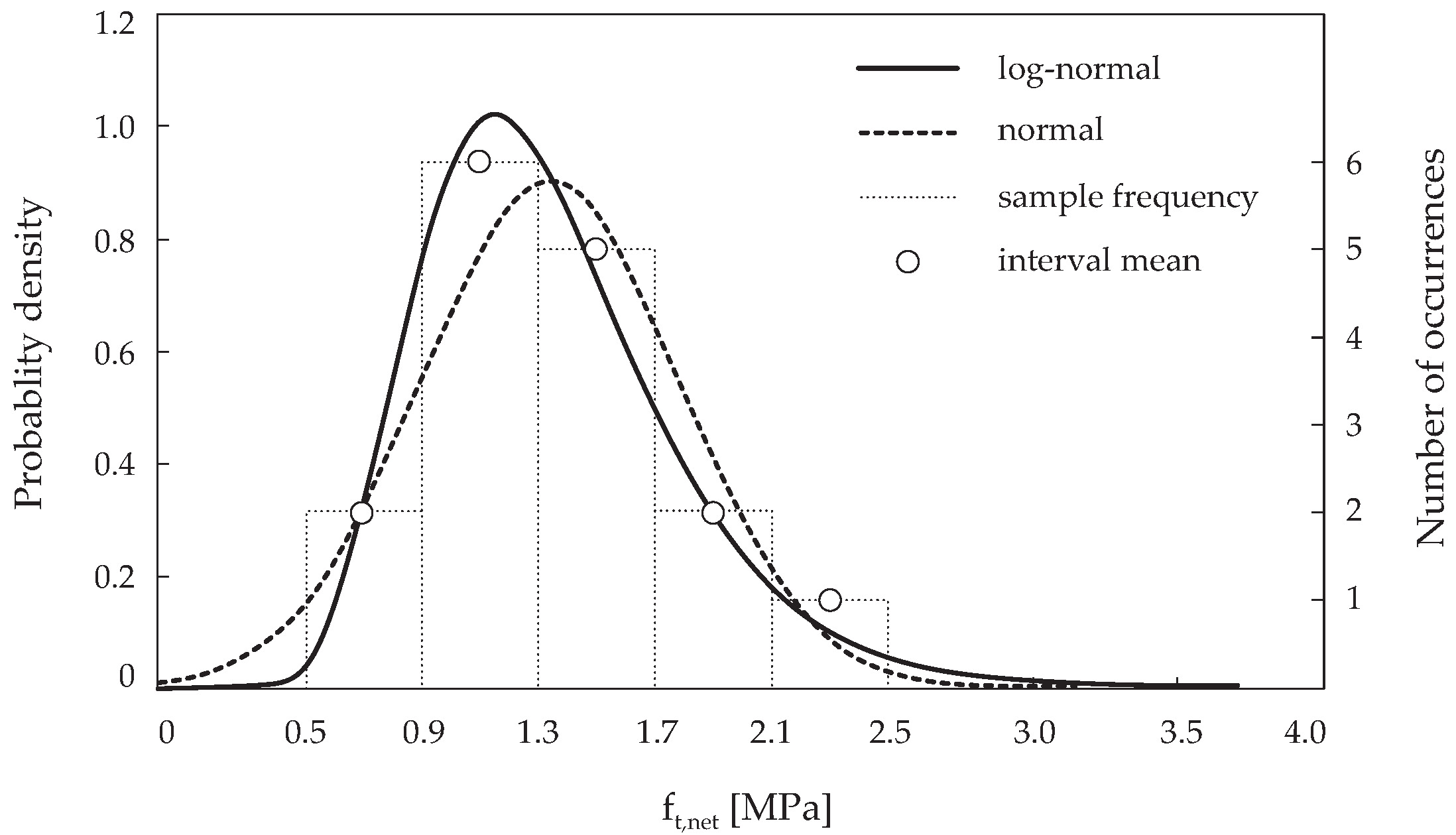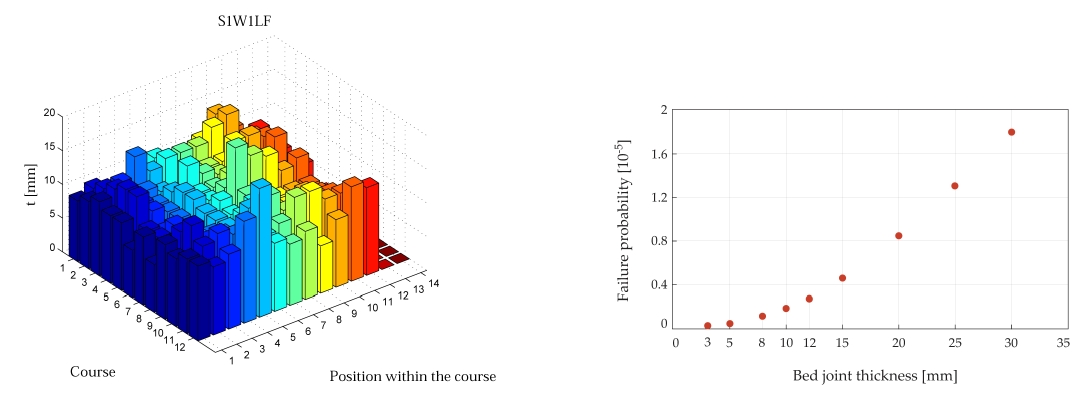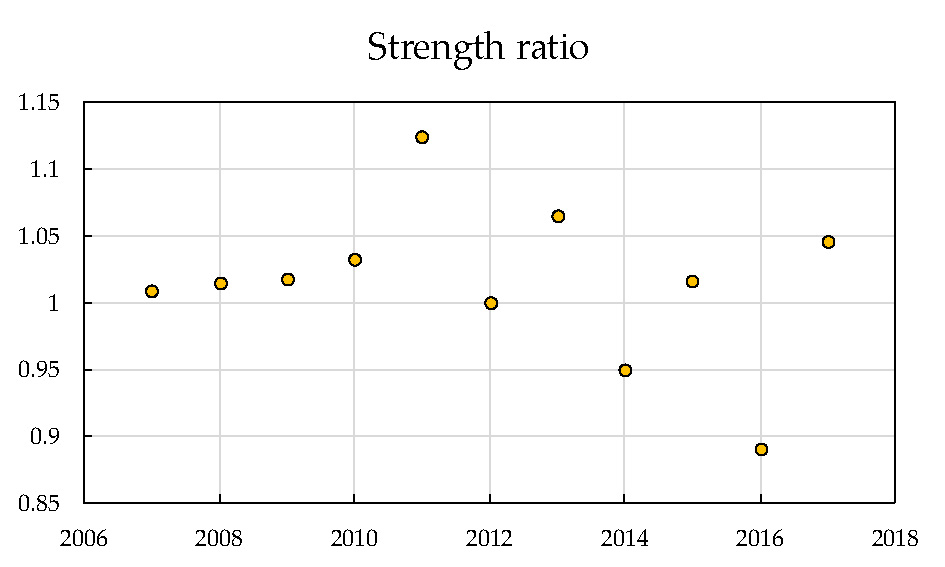Reliability of Structural Masonry
The long-term research project on reliability of structural masonry has been recently started at Institute of Structural Engineering. The main goal of the project is to extend the probabilistic model code by the Joint Committee on Structural Safety to also include a probabilistic model for structural masonry. Envisaged work will include a thorough survey and assessment of existing masonry material test results, establishing regression models between reference material properties and derived properties, identification of appropriate distribution types and parameters as well different selections of limit state functions together with their associated model uncertainties.
As the first step, the need and prerequisites for establishing a probabilistic model code for the design of masonry structures are discussed. Proposals are provided on the choice of basic material properties and preliminary ideas are given in regard to their probabilistic modeling. Typically governing uncertainties for the reliability of structural masonry are listed and the significance of different choices for the formulation of limit state functions are addressed. Finally, based on one typical load situation (out-of-plane bending) a reliability analysis based on two different code approaches is performed.
This work is presented in:
N. Mojsilovic, M.H. Faber: "Probabilistic Model Framework for the Design of Structural Masonry", Proceedings, Inaugural International Conference of the Engineering Mechanics Institute (EM08), Minneapolis, May 19-21, 2008, CD-ROM, Paper No. w805.
In the second step, the need and prerequisites for establishing a probabilistic assessment for the compressive strength of masonry are discussed. Some of the existing (deterministic) code provisions are outlined and ideas are given in regard to their probabilistic updating based on additional testing. Furthermore, the typically governing uncertainties are listed and their significance is addressed. Finally, based on one typical code relationship an updating analysis based on the Bayesian approach is performed. It could be shown that the Bayesian updating can provide more realistic design values for the masonry compressive strength than those that are found in the code.
The results of this part are outlined in:
N. Mojsilovic, M.H. Faber: "Probabilistic Assessement of Masonry Compressive Strength", Proceedings, International Conference on Structural Safety and Reliability (ICOSSAR2009), Osaka, Sep. 13-17, 2009, pp. 3609-3613.
Further developing this idea, a hierarchical Bayesian models were applied for the purpose of assessing the compressive strength of structural masonry. This establishes a fully probabilistic alternative to the existing semi-probabilistic approaches. The hierarchical framework offers versatile and powerful tools of uncertainty quantification and information aggregation at multiple system levels. Different types of uncertainty, i.e. ignorance and variability, are thoroughly managed, while heterogeneous types of information, e.g. data and expert knowledge, are consistently utilized. This way the analysis of the masonry wall resistance can be based on large-scale compression tests as well as on inexpensive tests of brick unit and mortar samples.
The results of this resarch are outlined in:
J.B. Nagel, N. Mojsilovic, B. Sudret: "Bayesian Assessment of the Compressive Strength of Structural Masonry", Proceedings, 12th International Conference on Applications of Statistics and Probability in Civil Engineering, ICASP12, Vancouver, Canada, July 12-15, 2015.
Further, the experimental study on the behaviour of swiss clay block masonry units subjected to direct tensile loading has been conducted. The specimens of two test series were subjected to direct tension in the z and y directions (directions perpendicular to the extrusion direction). Specimens behaved linear-elastically up to brittle failure, which occurred in the cross section with minimal net area. Net tensile strength obtained from tests exhibited large scatter, which seems to be mostly caused by initial cracking of the clay units. The ratio of net tensile to compressive strength of the block, based on the results of both test series, was about 4%. Statistical analysis of the test results shows that the observed test data could be represented both by log-normal and normal distributions whereas distribution parameters are estimated from the test data sample. However, having a zero lower bound log-normal distribution is, from a physical point of view, more appropriate for representing material strength. Moreover, keeping in mind its better fit to test results, the log-normal distribution is recommended.
This work is presented in detail in:
Mojsilovic N.: "external page Tensile strength of clay blocks: An experimental study", Construction and Building Materials, 25 (11), 2011, pp. 4156-4164.
Mortar joint thickness has a significant effect on capacity of structural masonry. Data on mortar joint thickness (bed and head joints) were collected from twelve typical storey-high walls at three different building sites and from four walls built in a research laboratory. The data obtained allowed an analysis of the spatial distribution of the joint thickness (figure below shows a typical spatial distribution of bed joint thickness) in each wall and the characterization of the probability distribution of joint thickness. The data has been statistically analysed and the results discussed. Considering a coefficient of variation of the joint thickness as a measure for the quality of work at the site it may be concluded that the quality of work on all sites, including the research laboratory was unsatisfactory and shows rather poor workmanship. Inspecting the spatial distribution of the mortar joint thickness within the single wall, anomalies typical for each building site, such as the greater thickness of the bed joints towards the top of the wall, as well as a smaller thickness in the lower part of the wall, were observed. Sometimes excessive thickness of the head joint towards the side ends of the wall was also observed.
The obtained probabilistic information was then used to define reliability-based limit state specifications where the joint thickness acts as an important random variable. A reliability analysis of the masonry under compression showed that probabilistic modelling of bed joint thickness results in higher reliability indices, compared to the reliability index obtained for the deterministic value of the bed joint thickness. Further, the level of the reliability, i.e., safety is different at different sites and the thinner joints are correlated to higher reliability indices, see figure below.
This work is presented in detail in:
Mojsilovic N.: "Statistical Analysis and Spatial Distribution of Mortar Joint Thickness for Clay Block Masonry Walls", Proceedings, 11th International Conference on Structural Safety and Reliability (ICOSSAR2013), Columbia University, New York, June 16-20, 2013, pp. 475-481.
Mojsilovic N. and Stewart M.G.: "external page Probability and structural reliability assessment of mortar joint thickness in load-bearing masonry walls", Structural Safety, 52, 2015, pp. 209-218.
As part of a course on structural masonry taught at ETH in Zurich, students are given an opportunity to do some practical work. During one lecture (one and half-hours) students are divided in smaller groups (five to six students) and each group is asked to build a standard masonry specimen (according to the European testing standard EN-1052-1), see figure below. Simultaneously, two professional masons, which are instructing/helping students during the exercise, are asked to build one specimen. After the prescribed curing time all specimens are tested and the corresponding results (masonry compressive strength) are discussed with students.
In the course of eleven years, professional masons could not over-perform unskilled students. Moreover, the strength of wallettes built by the masons was almost equal to the average value of those built by the students. One possible explanation for such an outcome could be that the professional masons are more consistent in their work and thus their values are always in the middle. The diagram below shows the strength ratio of wallettes build by masons to the mean value of those built by student (one point for each year).
On the other hand, from a broader point of view a question that arises is if the skill is (so) important, it seems that the only advantage of professional masons is their construction speed. Other advantages such as high quality and low variability of workmanship seem to be overcome by uncertainty.
There may also be less incentives for masons to produce consistent high quality work as masonry in compression rarely fails in building structures, so their task may not be viewed as safety critical. Speed of construction is likely to be a higher priority. Motivation is a key driver to good performance, and it might be that students are more motivated in their task than the masons in this case.
This topic is discussed in detail in:
Mojsilović N. and Stewart M.G.: "external page Influence of Workmanship on the Compressive Strength of Structural Masonry", Proceedings, 13th International Conference on Applications of Statistics and Probability in Civil Engineering, ICASP13, Seoul, South Korea, May 26-30, 2019.




